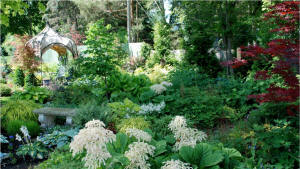|
 Shade
Gardening Beyond Hostas Shade
Gardening Beyond Hostas
By Melinda Myers
 Send a link to a friend
Send a link to a friend
[April 29, 2018]
A
shady spot provides welcome relief from the summer heat; but it can
make growing a beautiful garden a bit more challenging. Take heart,
your landscape may receive more sunlight than you suspect and if
not, there are quite a few shade-tolerant plants you can grow.
|
|
 Evaluating the sun and shade patterns throughout
the day, season, and year is a good place to start. Sun-loving bulbs
need lots of sun early in the season before most trees leaf out,
while other plants need sunlight throughout the growing season. If
you work all day, you may assume those shady spots in the morning
and evening never light up, so take some time to evaluate the sun
and shade conditions throughout the season. Evaluating the sun and shade patterns throughout
the day, season, and year is a good place to start. Sun-loving bulbs
need lots of sun early in the season before most trees leaf out,
while other plants need sunlight throughout the growing season. If
you work all day, you may assume those shady spots in the morning
and evening never light up, so take some time to evaluate the sun
and shade conditions throughout the season.
Make a list of plants that you have had success with and those that
failed in the shady location. Use these to help you select or avoid
plants with similar light requirements. For example, if peonies
bloom and tomatoes produce fruit this area receives quite a bit of
sunlight, perhaps more than you thought.
If your landscape is too shady to grow the plants you desire, try
increasing the sunlight reaching ground level plantings. Hire a
certified arborist to thin the overhead tree canopy. They have the
training and experience to do the job safely and correctly. You
don’t want to damage the health and structure of established trees,
so critical to the beauty of your landscape.
If there’s too much shade to grow even shade-loving plants, consider
mulch to keep the mud in place, permeable pavers and a table or
chair for relaxing, or a few steppers and moss to create a moss
garden.
Once you’ve made your selections and planted your garden, you need
to adjust the care to compensate for the limited light conditions.
Plants growing under large trees or overhangs need to be watered
more often, especially the first year or two until they become
established. The dense canopy of many trees and impervious overhangs
prevent rainfall from reaching the ground below. Plus, the extensive
root systems of trees and shrubs absorb much of the rainfall that
does make it through, so check soil moisture several times a week
and water thoroughly as needed.

Tree and shrub roots can also compete with plantings for nutrients.
Use a low nitrogen, slow release fertilizer like Milorganite (milorganite.com)
that promotes steady above and below ground growth. The 85% organic
material further helps improve the soil. Apply slow release
fertilizers at planting and once again for annuals mid-season.
Fertilize new and established perennials in early spring and again
in mid-summer as needed.
[to top of second column] |

Avoid high nitrogen, quick release fertilizers that
promote lush succulent growth that is more susceptible to insects
and diseases. And with limited light as a potential plant stressor,
this can increase the risk of problems.
When planting under or near trees be careful not to kill them when
creating your shade garden. Adding as little as an inch of soil over
the roots can kill some tree species. And deep cultivation can
damage the feeder roots critical for water and nutrient absorption
since the majority grow within the top 12 inches of soil.

Here is a list of just a few shade-tolerant perennials to consider.
As always make sure the plants also tolerate your region’s climate.
And once you start reviewing the internet and plant catalogues you
may find it difficult to narrow down your choices to fit in your new
shade garden.
Woodland Wildflowers
Spring Flowering Bulbs
Grape hyacinths
Checkered lilies
Camassia
Daffodils
Virginia Bluebells
Perennial Flowers
Ajuga
Astilbe
Barrenwort (Epimedium)
Bleeding Heart
Bugbane/Snakeroot (Actaea)
Columbine
Coral Bells
Deadnettle (Lamium)
Ferns
Foam flower (Tiarella)
Ginger (Asarum)
Hostas
Japanese Forest Grass (Hakonechloa)
Lungwort
Sedges
Siberian Bugloss (Brunnera)
Variegated Solomon Seal
Toadlily (Tricyrtis)
[Photo by Melinda Myers]
Melinda Myers has written over 20
books, including Small Space Gardening and The Midwest Gardener’s
Handbook. She hosts The Great Courses “How to Grow Anything” DVD
series and the nationally syndicated Melinda’s Garden Moment TV &
radio segments. Myers is a columnist and contributing editor for
Birds & Blooms magazine and was commissioned by Milorganite for her
expertise to write this article. Myers’ web site is
www.melindamyers.com. |